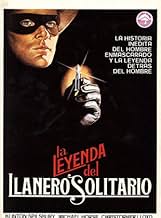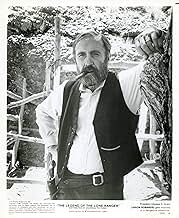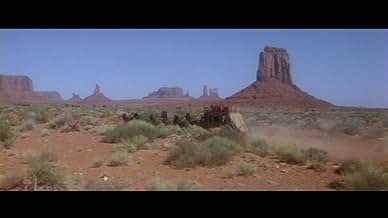Aggiungi una trama nella tua linguaThe sole surviving Texas Ranger (Klinton Spilsbury) of an ambush arranged by outlaw leader Major Bartholomew "Butch" Cavendish (Christopher Lloyd) returns to fight back as a great masked wes... Leggi tuttoThe sole surviving Texas Ranger (Klinton Spilsbury) of an ambush arranged by outlaw leader Major Bartholomew "Butch" Cavendish (Christopher Lloyd) returns to fight back as a great masked western hero, The Lone Ranger.The sole surviving Texas Ranger (Klinton Spilsbury) of an ambush arranged by outlaw leader Major Bartholomew "Butch" Cavendish (Christopher Lloyd) returns to fight back as a great masked western hero, The Lone Ranger.
- Regia
- Sceneggiatura
- Star
- Premi
- 4 vittorie e 4 candidature totali
Recensioni in evidenza
First appearing on radio station WXYZ (Detroit) in 1933 and created by either station owned George W. Trendle or by writer Fran Striker (matter of some debate), the series while initially aimed at children managed to exhibit a broader reach than anticipated with over the half the audience consisting of adults. The success of the character and radio program lead to expansion of the character to other areas including books (many written by Striker), two Republic Pictures produced film serials, and most famously the 1949-1957 TV series adaptation starring Clayton Moore and Jay Silverheels as The Lone Ranger and Tonto respectively. After the series ended Moore continued to make appearances as the character at Children's Hospitals, Fairs, and charitable events having identified with the character. Rights to the character were eventually bought by oil billionaire Jack Wrather, who sought to make a feature film adaptation of the character for modern audiences. Development on the film was sped along by the success of 1978's Superman encourages financiers to revive other older Ips and characters including The Lone Ranger. The movie was beset by problems including Klinton Spilsbury who portrayed the character in the film whose behavior was reported to be problematic with the actor often getting into brawls, showing up to set drunk, or acting with an unearned air of arrogance. Spilsburry's performance was deemed weak and was eventually dubbed over by actor James Keach (who later said Spilsburry's performance wasn't THAT bad but it was an easy payday), but the biggest negative publicty came from Wrather's treatment of Clayton Moore who obtained an injunction against Moore from making any appearances as The Lone Ranger in public out of fear his continuing to do so would confuse audiences. Moore continued to make appearances using wraparound sunglasses and eventually won a countersuit that allowed him to continue. When the movie was released, the film was a massive disaster and alongside Heaven's Gate is credited with making the western genre less bankable at the box office (though Lone Ranger would mitigate its losses thanks to healthy TV sales). The Legend of the Lone Ranger is considered a black mark on the character, but is it really that bad?
One of the major criticisms of The Legend of the Lone Ranger was in the hour long lead up before John Reid dons the mask, a point producer Lew Garde would concur with in his memoirs saying in hindsight the backstory should've been done away with in the first ten minutes. The movie does take a long time before Reid finally dons the mask, but I do understand why the hour exists in relation to the rest of the story. The movie tries to set up the relationship of both Tonto and Reid from the days of their youth (only hinted at in the TV series) and give us more insight into the motivation behind the characters and their relationship. It's not bad in theory, and the sequence where we see Reid raised alongside Tonto is definitely influenced from contemporary westerns of the 70s such as Little Big Man or A Man Called Horse that tried to give more depth to Native American characters in contrast to the majority of productions of the 40s,50s, and 60s, with instances like Tonto in The Lone Ranger being the exception rather than the rule. I think what doesn't work is the story beat of John being sent to Illinois so he can study law because it feels like it distances him a bit too much from both Tonto and Reid's brother Dan with Tonto being absent for nearly a half-hour until the 50 minute mark.
Klinton Spilsbury is a major issue with the movie, he looks fine as The Lone Ranger and looks like a leading man, but with his voice dubbed noticeably by another actor we don't have a "full" performance for the character and instead we have two halves of a performance crudely stapled together. This was Spilsbury's only film role and I'm not sure how fair I can judge his performance since I'm not experiencing all of it, but as is its unfortunately not all that great. I did enjoy Michael Horse as Tonto in what was Horse's film debut and Horse would go on to have a respectable career as a character actor notably playing Deputy Hawk on the cult TV show Twin Peaks. Most of the supporting cast is really good with Christopher Lloyd's take on Butch Cavendish as a rogue separatist union Major bent on establishing the Republic of New Texas by kidnapping President Grant is a fun premise and Lloyd's intensity makes him seem like a force to contend with, similarly Jason Robards is very entertaining as President Grant with his grizzled demeanor and acerbic commentary leading to some fun exchanges between him and Lloyd.
The movie is the final directorial feature of noted cinematographer William A. Fraker of Bullitt and Rosemary's Baby among others, and having directed well regarded Lee Marvin western Monte Walsh in 1970, it's clear Fraker knows how to direct and stage an epic and energized western. The action sequences are brutal and chaotic with a sense of weight to them with the Stagecoach set piece in particular featuring some beautiful vistas as well as some thrilling sequences. The movie was very expensive for the time and you can see the money on screen with how elaborate the action sequences are. Unfortunately what drags them down is the lack of a strong lead and thanks to the dubbing and dragging nature of the first half of the film, Spilsbury and Horse really don't replicate the chemistry Moore and Silverheels managed to convey in just 66 minutes that this movie tries to do with 97 minutes.
The Legend of the Lone Ranger is okay. There's some strong performances from Lloyd, Horse, and Robards, and the action is suitably engaging with elaborate stunts and set pieces where the money was clearly spent, but the lack of chemistry between Spilsbury and Horse, as well as the fact there's not really a "full" performance for The Lone Ranger makes for a pretty noticeable weak point in the movie. It's not a complete failure and there is some fun to be had, but it's pretty hard to ignore some major faults.
The magic of this film, for me, is the first half, when we see how John Reid becomes the Lone Ranger.Also, a great scene where he finds a wild white horse, breaks him, and names him Silver. But a later scene just blew my mind away.
In that scene,after Reid and Tonto bury his brother and the other ambushed Texas Rangers, he decides to wear a mask so the bad guys won't recognize him. He tells Tonto the mask will be a symbol of justice. At this point, we have not yet seen his alter ego.
That changes when we see him from the back kneeling at his brother's grave and vowing to avenge his death. Then he puts his hat on, turns around, and as we see him in his mask for the first time, blaring trumpets sound out the start of the William Tell Overture. Being a Lone Ranger fan, this literally sent shivers down my spine.
The scene continues as they both ride away to more of the overture, and, of course, we hear "Hi yo, Silver, away."
Breathtaking!
Legendary bomb. The idea was not a bad one--reinvent and introduce the Lone Ranger for 1980s audiences. Right off the bat though there were problems. The studio ordered Clayton Moore (the original Ranger) to stop appearing anywhere as the Lone Ranger. It led to a nasty little battle that made headlines. I know of people who refused to see the film because of how Moore was treated. Also they hired the awesomely untalented Klinton Spilsbury to play the Ranger. Spilsbury was very handsome and muscular but had absolutely no charisma and just couldn't act. In fact his whole vocal performance was redubbed by another actor! Also his off screen antics (public drunkenness and beating people up) didn't help matters. Acting aside, the script is dull and slow. Also the Ranger himself doesn't show up until an HOUR in! There were some complaints at the time that the movie was too violent for a PG. However I don't think it was that bad.
There are a few (very few) things done right here--the photography was truly beautiful; Michael Horse was excellent as Tonto; Christopher Lloyd is lots of fun as the villain and when the Lone Ranger finally shows up (with the William Tell Overture booming from the soundtrack) it's really rousing. But, all in all, this is a boring and terrible attempt to bring back the Lone Ranger. It's easy to see why this bombed. A 4--mostly for the photography.
Lo sapevi?
- QuizThe filmmakers were disappointed with Klinton Spilsbury's line readings, and wanted an actor with a stronger voice. James Keach dubbed his lines.
- BlooperEarly in the movie, John Reid gives Amy Striker a copy of the book "A Century of Dishonor" by Helen Hunt Jackson, written in 1881.
- Citazioni
[last lines]
President Ulysses S. Grant: Who is that masked man?
The Lone Ranger: Hi-Yo, Silver! Away!
- Versioni alternativeUK versions are cut by 5 secs to remove horse-falls.
I più visti
- How long is The Legend of the Lone Ranger?Powered by Alexa
Dettagli
- Data di uscita
- Paese di origine
- Lingua
- Celebre anche come
- El llanero solitario
- Luoghi delle riprese
- Aziende produttrici
- Vedi altri crediti dell’azienda su IMDbPro
Botteghino
- Budget
- 18.000.000 USD (previsto)
- Lordo Stati Uniti e Canada
- 12.617.845 USD
- Fine settimana di apertura Stati Uniti e Canada
- 2.945.600 USD
- 25 mag 1981
- Lordo in tutto il mondo
- 12.617.845 USD
- Tempo di esecuzione1 ora 38 minuti
- Mix di suoni
- Proporzioni
- 2.35 : 1
Contribuisci a questa pagina
































